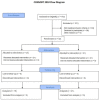Comparison of the UEscope Video Laryngoscope with the Traditional Direct Laryngoscope in Neonates and Infants: A Randomized Clinical Trial
- PMID: 36010051
- PMCID: PMC9406870
- DOI: 10.3390/children9081161
Comparison of the UEscope Video Laryngoscope with the Traditional Direct Laryngoscope in Neonates and Infants: A Randomized Clinical Trial
Abstract
The role of video laryngoscopy in adults is well established, but its role in children is still inconclusive. Previous studies on the UEscope in pediatric patients with difficult airways showed that it could reduce the time to intubation (TTI) compared to a conventional direct laryngoscope. The main objective of the current study was to investigate if the use of the UEscope could reduce the TTI in neonates and infants. Forty patients under 12 months old were recruited from a single tertiary hospital from March 2020 to September 2021 and were randomly assigned to the direct laryngoscope group (n = 19, neonates = 4, infants = 15) or UEscope group (n = 21, neonates = 6, infants = 15). Although the quality of glottic view was comparable in both groups, the TTI was significantly lower in the UEscope group in both the "intention-to-treat" (-19.34 s, 95% confidence interval = -28.82 to -1.75, p = 0.0144) and "as treated" (-11.24 s, 95% confidence interval: -21.73 to 0, p = 0.0488) analyses. The UEscope may be a better choice for tracheal intubation than conventional direct laryngoscope in neonates and infants.
Keywords: child; infant; intubation; laryngoscopes; newborn.
Conflict of interest statement
The authors declare no conflict of interest.
Figures








Similar articles
-
Comparison of Miller laryngoscope and UEScope videolaryngoscope for endotracheal intubation in four pediatric airway scenarios: a randomized, crossover simulation trial.Eur J Pediatr. 2019 Jun;178(6):937-945. doi: 10.1007/s00431-019-03375-y. Epub 2019 Apr 11. Eur J Pediatr. 2019. PMID: 30976922 Free PMC article. Clinical Trial.
-
Current Evidences for the Use of UEscope in Airway Management.Chin Med J (Engl). 2017 Aug 5;130(15):1867-1875. doi: 10.4103/0366-6999.211536. Chin Med J (Engl). 2017. PMID: 28748861 Free PMC article. Review.
-
Comparison of GlideScope Video Laryngoscopy and Direct Laryngoscopy for Tracheal Intubation in Neonates.Anesth Analg. 2019 Aug;129(2):482-486. doi: 10.1213/ANE.0000000000003637. Anesth Analg. 2019. PMID: 29985811 Clinical Trial.
-
A comparison of the STORZ video laryngoscope and standard direct laryngoscopy for intubation in the Pediatric airway--a randomized clinical trial.Paediatr Anaesth. 2009 Nov;19(11):1102-7. doi: 10.1111/j.1460-9592.2009.03127.x. Epub 2009 Aug 25. Paediatr Anaesth. 2009. PMID: 19708910 Clinical Trial.
-
Pediatric video laryngoscope versus direct laryngoscope: a meta-analysis of randomized controlled trials.Paediatr Anaesth. 2014 Oct;24(10):1056-65. doi: 10.1111/pan.12458. Epub 2014 Jun 24. Paediatr Anaesth. 2014. PMID: 24958249 Review.
Cited by
-
Videolaryngoscopy versus direct laryngoscopy for tracheal intubation in neonates.Cochrane Database Syst Rev. 2023 May 12;5(5):CD009975. doi: 10.1002/14651858.CD009975.pub4. Cochrane Database Syst Rev. 2023. PMID: 37171122 Free PMC article. Review.
-
Global research trends in prediction of difficult airways: A bibliometric and visualization study.Medicine (Baltimore). 2023 May 12;102(19):e33776. doi: 10.1097/MD.0000000000033776. Medicine (Baltimore). 2023. PMID: 37171310 Free PMC article.
-
Video laryngoscopy in neonate and infant intubation-a systematic review and meta-analysis.Eur J Pediatr. 2024 Nov 20;184(1):34. doi: 10.1007/s00431-024-05839-2. Eur J Pediatr. 2024. PMID: 39565430 Free PMC article.
References
-
- Motoyama E.K., Finder J.D. Chapter 3, Respiratory Physiology. In: Peter D., Franklyn C., editors. Smith’s Anesthesia for Infants and Children. 10th ed. Elsevier; Philadelphia, PA, USA: 2021. pp. 28–77.
-
- Fiadjoe J.E., Nishisaki A., Jagannathan N., Hunyady A.I., Greenberg R.S., Reynolds P.I., Matuszczak M.E., Rehman M.A., Polaner D.M., Szmuk P., et al. Airway management complications in children with difficult tracheal intubation from the Pediatric Difficult Intubation (PeDI) registry: A prospective cohort analysis. Lancet Respir. Med. 2016;4:37–48. doi: 10.1016/S2213-2600(15)00508-1. - DOI - PubMed
Grants and funding
LinkOut - more resources
Full Text Sources

